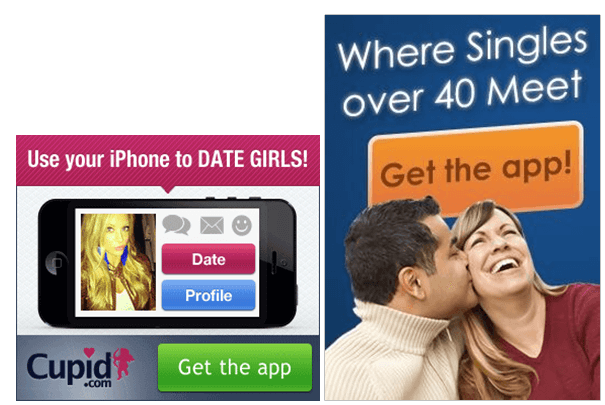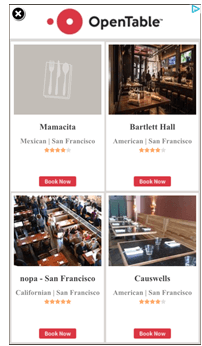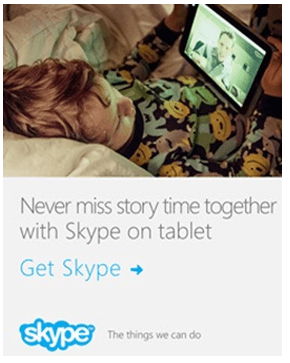How to tailor your app display ads to targeted segments
Are you tapping into the power of segmentation with your app ad creatives? Columnist Craig Weinberg takes a look at some brands that are doing it the right way so that you can learn from them.

Segmentation is picking up steam as one of the biggest digital marketing buzzwords of 2016, and it’s proven to be highly effective in smart brands’ creative strategies. In this post, we’ll take a look at some tenets — and good examples — of putting segmentation to work in your app ad creatives.
First, we’ll dive into some of the distinguishing factors in app creatives. Then we’ll show a few examples (Note: these are screen shots, and the companies are not our clients) showing best segmentation practices in play.
Let’s get started.
A few notes on app ad creatives
Right off the bat, here are five things you need to know about mobile creatives in general and app ad creatives in particular:
1) They’re personal.
These aren’t ads on your TV or in a direct mailer — or, for that matter, on a result of a basic AdWords query. They’re for you, on your most intimate device, your smartphone, and they’d better reflect that they know what you’ll find relevant.
2) They’re measurable.
Every part of the ad can be attributed to an ROI (return on investment) goal. The value prop, the background color, the CTA — you can test them all and see what’s working and what’s not. (And don’t just test for click-through rate and stop there; test all the way down to actions taken within the app.)
3) They’re limitless.
Technology allows us to target the smallest cohorts with their own unique messages. You might know a few demographic personas (e.g., 35- to 44-year-old men in the Phoenix area) from your CRM (customer relationship management) data, but layer on parental status, say, and now you’re cooking.
4) They’re small.
You don’t have a ton of space to work with, so your message must be clear — both in layout and in meaning.
5) They have a very short exposure time.
App install ads get less attention than almost any other ad format, so — echoing the best practices in #4 — your creative and messaging must both stand out and be easily, quickly digested by the user.
App ad segmentation examples and lessons
To give you an idea of what segmentation looks like in action, we’ll provide examples of ads segmented by age, gender, location and parental status, and then we’ll look at a few examples of motivational segmentation.
Segmentation by age
This side-by-side comparison of ads for the same dating app shows how effectively messaging can vary by age group targeted:

In the ad on the left, targeting 20-somethings, the messaging is about quick-hit dating. In the ad on the right, targeting 40-somethings, the messaging plays on partnership (where singles meet to become pairs).
Segmentation by gender
Gender segmentation, especially for ecommerce, is usually pretty straightforward:

On the left, a men’s product; on the right, a bunch of women’s products. The men’s version appeals to brand names; the women’s appeals to styles and seasonal trends. The messaging (we assume) was put through cycles of testing to see which worked better.
Segmentation by location
Location segmentation opens up a range of options in targeting and messaging. If you know the user’s location, messaging can play on (for instance):
Proximity

Geo-specific offers

Local options

Segmentation by parental status
Appeals to single, flexible, drop-of-a-hat folks are much different from appeals to parents. Take, for example, this Skype ad, which is clearly tugging on the conscience-ridden heartstrings of parents away from home by offering their product as the next best thing:

Segmentation by motivation
Yahoo’s app is great for delivering news; that’s easily traced to the company’s roots. But different people consume the news differently, and with different motivations, as reflected in these three creatives:

And, back to dating app Cupid, here’s another juxtaposition of creatives by motivation (play the field vs. find the one):

The number of segmentation variables in play for your brand will depend heavily on the products or services you’re selling. And with any creatives, of course, you need to establish testing cycles to determine winners (and winning themes).
Ultimately, your app ad creatives should speak directly to the needs and desires of a very specific audience. Smart segmentation and creative should do more than boost your install volume; it should ensure that you’re reaching the people most likely to engage with your app after download (which is where the magic happens).
Contributing authors are invited to create content for MarTech and are chosen for their expertise and contribution to the search community. Our contributors work under the oversight of the editorial staff and contributions are checked for quality and relevance to our readers. MarTech is owned by Semrush. Contributor was not asked to make any direct or indirect mentions of Semrush. The opinions they express are their own.
Related stories
New on MarTech